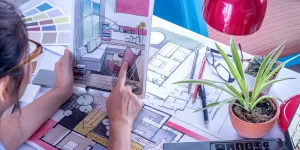The COVID 19 outbreak in the year 2020 has seen a new world order in many ways. “Social distancing” has defined new parameters for formal and informal interactions.
Let’s take a reality check!
As the coronavirus takes a steep toll on the economy, many might not have jobs to go back to. Some, who are still employed, may have to work from home for a very long, indefinite time. Co-working spaces will probably never be what they once were as hot desks and communal spaces might have to be replaced with more sanitary – but less economical – private areas. The Covid-19 crisis will force permanent changes in both commercial real estate and work culture everywhere. Thus, the office as we know it might never be the same.
If we roll back a little in time, we notice that working from home was becoming the trend before Covid-19 days. New technology and company cultures supporting this working style were on the rise. So, it’s quite likely that many people who had been working from home might continue to do so even after the pandemic.
Here’s what business heads have to say:
“Any skepticism will go away because companies recognize that remote work does work.”
“We don’t believe that we need more than 25% of our workforce at our facilities in order to be 100% productive,” says NG Subramaniam (TCS’s COO)
“Overall, working from home doesn’t change your day-to-day work, it just means you’ll be doing it from a different environment.” Say Christie who has interestingly, promised to reimburse employees’ expenses required to set up home offices.
Let’s take a pragmatic look at the post Pandemic Lockdown trends.
Post lock down, corporates as well as businesses will start operations, albeit, with reduced staff physically attending office. Companies will continue to insist on increasing the number of employees working from home. In the wake of the fear of COVID infection, employees themselves would also prefer this work format.
“As people are forced to work from home, personal space becomes an office. In a way, we’ve dramatically expanded the amount of office space we have.” – Tim Savage (NYU’s Schack Institute)
This highlights certain inferences regarding residential vis-a-vis commercial real estate balance.
- A majority of urban families have a double income status, i.e. both partners are working. Coupled with this, the children (one or two) would also be on a remote learning model, as educational institutions will continue to be under lock down. This situation creates a need for clear “individual work zones” in the home. Hence, a residence should be able to accommodate and create work zones, to satisfy all the family members working at the same time.
- Although commercial properties will continue to exist, their size in terms of square feet will reduce. Additionally, as more employees need to work out of home, larger residential spaces (i.e. sq. ft.) would be desired. This will see a trend in compact commercial offices but larger, more spacious homes.
- Certain small businesses that were on a verge of launch, will rethink their need for a physical office space. As digital is the future of most businesses, they would choose to entirely shift to a work from home model. Instead of spending revenue on commercial rental, office infrastructure, money spent on commute, etc; they would prefer compensating employees for the tech and design infrastructure needed to smoothly run home offices. This will completely reduce the demand for mid-sized commercial office spaces and also co-work environment.
- The fact that “WorkingFromHome” is going to be the new normal, interior design of both commercial and residential spaces will have to change to support it.
For the home, whether self-owned or rented, certain design additions will be in demand. “Work Zones” will need to have appropriate privacy, adequate lighting, high speed Wi-Fi. In terms of presentation, the “Work Zone” will need to be Video conferencing savvy with sensitivity toward impactful back drops, high resolution cameras + microphones, color schemes, etc.






